What is Hoi An’s Carpentry Village Kim Bong like?
Kim Bong Carpentry Village is a peaceful riverside community on Cam Kim Island, just across the Thu Bon River from Hoi An. It’s known for its generations of skilled woodworkers who specialize in shipbuilding, intricate carvings, and architectural restoration. While the pace here is slow and traditional, you’ll find a mix of old-world craftsmanship and modern techniques still in daily use.

The village’s roots stretch back to the 16th and 17th centuries, when Hoi An was a bustling international port. Kim Bong — along with other nearby craft villages — supplied everything from boats and furniture to wooden temples and assembly halls. Today, it remains one of the few places in Vietnam where you can observe centuries-old woodworking traditions firsthand.
History of Kim Bong Carpentry Village
Kim Bong Carpentry Village was established in the 15th century by skilled craftsmen who migrated from northern Vietnam. As Hoi An grew into a major trading port during the 16th and 17th centuries, the village’s carpenters became essential in building merchant ships, bridges, temples, and homes — many of which still stand in Hoi An today.
Their work was not only practical but artistic, blending influences from Vietnamese, Cham, Chinese, and Japanese styles. Kim Bong carpenters also contributed to the construction of imperial buildings in Hue. Even now, the village plays an important role in heritage preservation, with artisans often called upon to restore ancient wooden structures across central Vietnam.
What to see and do
A visit to Kim Bong Carpentry Village isn’t a big sightseeing tour — it’s a quiet, local experience that gives you a behind-the-scenes look at one of Hoi An’s oldest crafts. Expect a peaceful rural setting, a few working carpentry shops, and friendly locals who are used to curious visitors dropping by. Here’s what you can actually see and do when walking through the village:
1. Watch traditional woodcarving
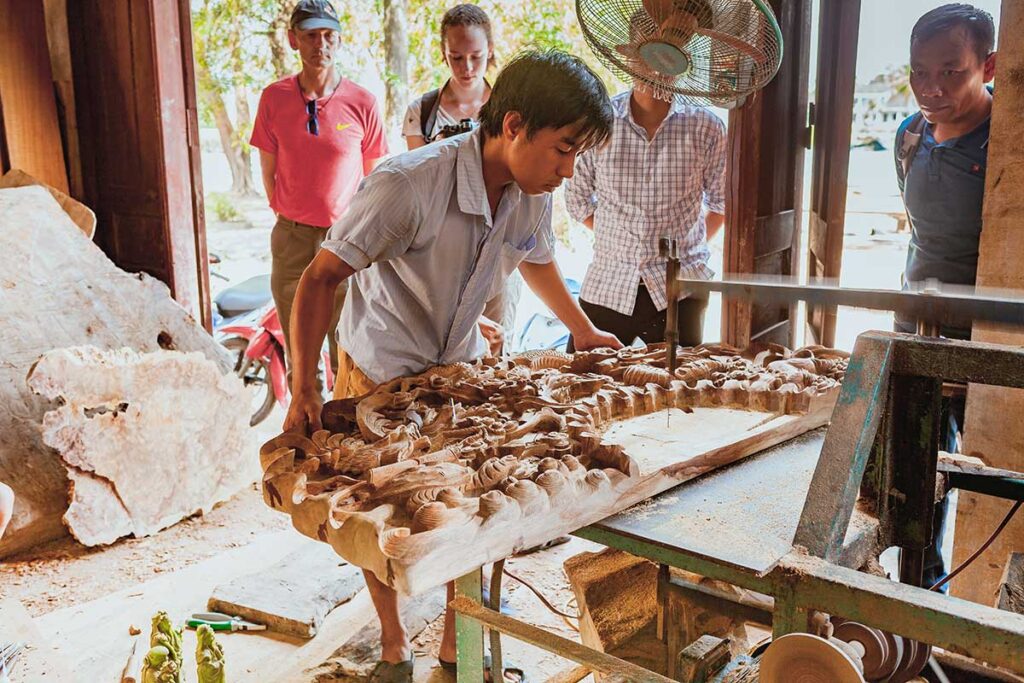
As you stroll through the village’s western side, you’ll pass open-air or semi-enclosed workshops where skilled artisans carve wood by hand using traditional tools. You’re welcome to stop and watch — no need to book anything. You’ll often see craftsmen working on furniture pieces, decorative panels, statues of Buddha or guardian animals, and intricate temple elements.
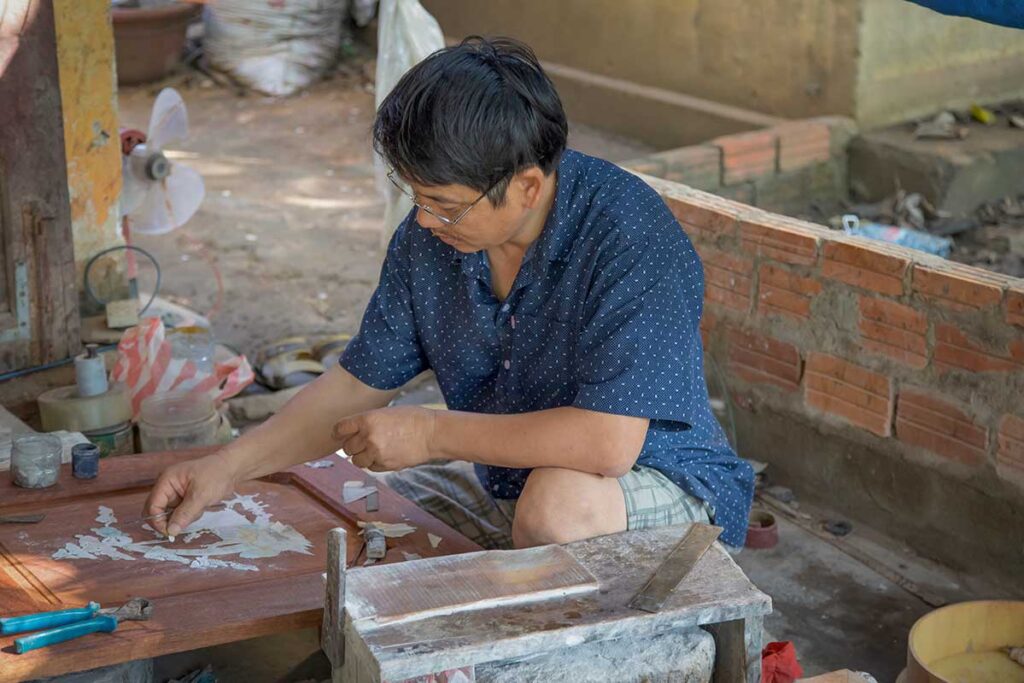
Some artisans are happy to chat and explain their work (basic English or through gestures). The carving is slow, precise work, and it gives you a real sense of the craftsmanship behind Hoi An’s iconic architecture.
Practical tip: These shops are informal. No signs, no tour groups — just peek in and say hello politely. Most shops are open from around 8:00 AM to late afternoon.
2. Explore the shipbuilding area

The eastern side of the village, closer to the riverbank, is where you’ll find the larger structures used for boatbuilding and repair. These aren’t tourist displays — they’re working spaces where wooden fishing boats are built using traditional designs, some with modern updates. The scale is impressive, and it gives insight into how important shipbuilding still is in coastal Vietnam.

You may see workers planing planks, sealing hulls, or sanding wood — it’s hands-on labor, often passed down through generations.
Good to know: Access is open, but please don’t walk onto boats or interrupt people working. It’s fine to take photos from a respectful distance.
3. Visit the souvenir shops
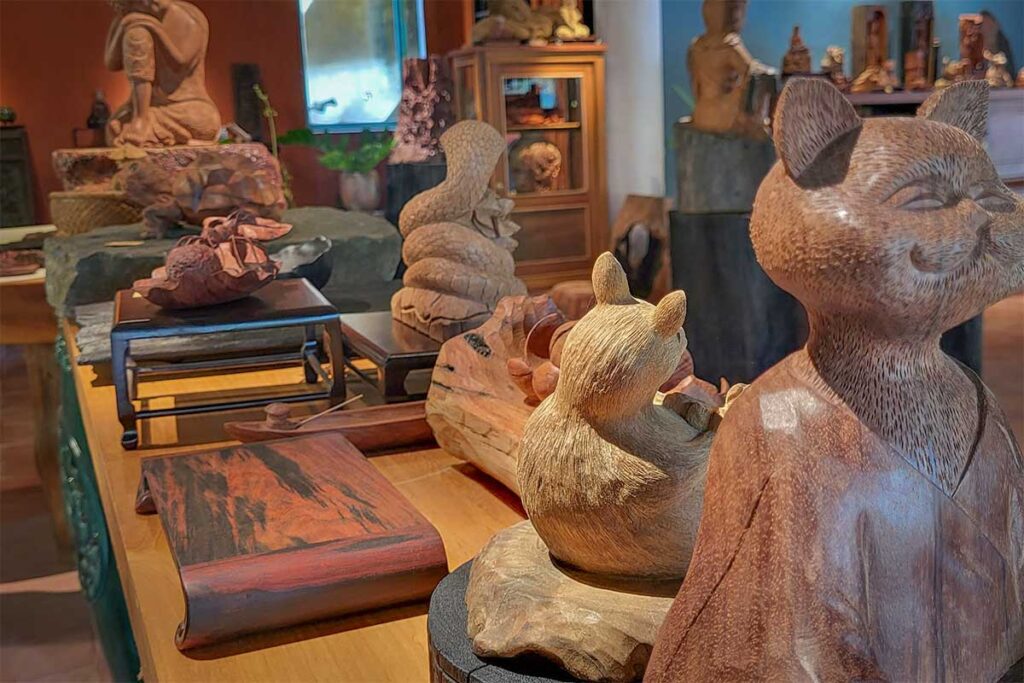
There are a handful of modest souvenir shops along the village’s main lanes. These are mostly family-run and sell wooden items made right there in the village — small statues, carved animals, wall hangings, incense holders, and spiritual decor.
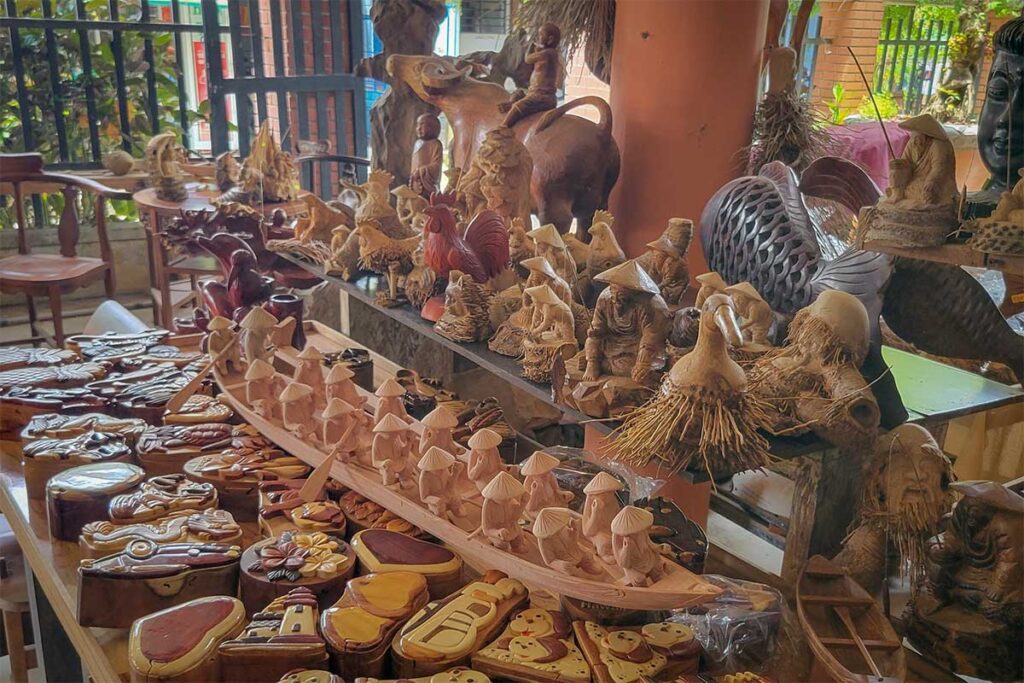
Prices are reasonable, and since they use leftover wood from furniture or construction projects, many items are eco-friendly and one-of-a-kind.
Buying tip: Items are usually priced, but bargaining is okay — keep it polite and friendly.
4. Try a woodcarving workshop

Some workshops (not all) offer short hands-on carving sessions for travelers, usually lasting 30 to 60 minutes. You’ll get a piece of soft wood, basic tools, and guidance from a local carver — no experience needed. You can carve a simple design like your name, a symbol, or a small animal figure.
These workshops are simple but meaningful — especially if you enjoy crafts or want to support the local artisans more directly.
How to arrange: You can ask when you arrive, or better yet, go with a guide or book a half-day cycling tour that includes the workshop. Not all carvers speak English, so a guide helps.
5. Walk through the village
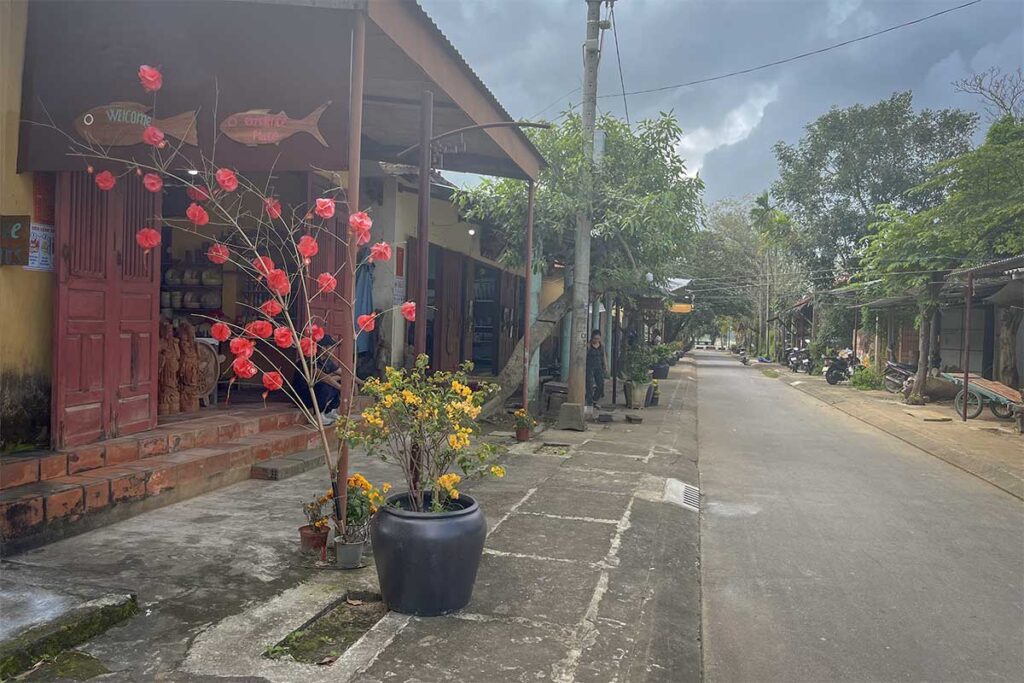
Part of the experience is just wandering. Kim Bong is still a real village — quiet streets, kids riding bikes, wooden homes shaded by trees, and the sound of chisels in the distance. There’s no entrance fee or formal route, just small paths you can explore freely.
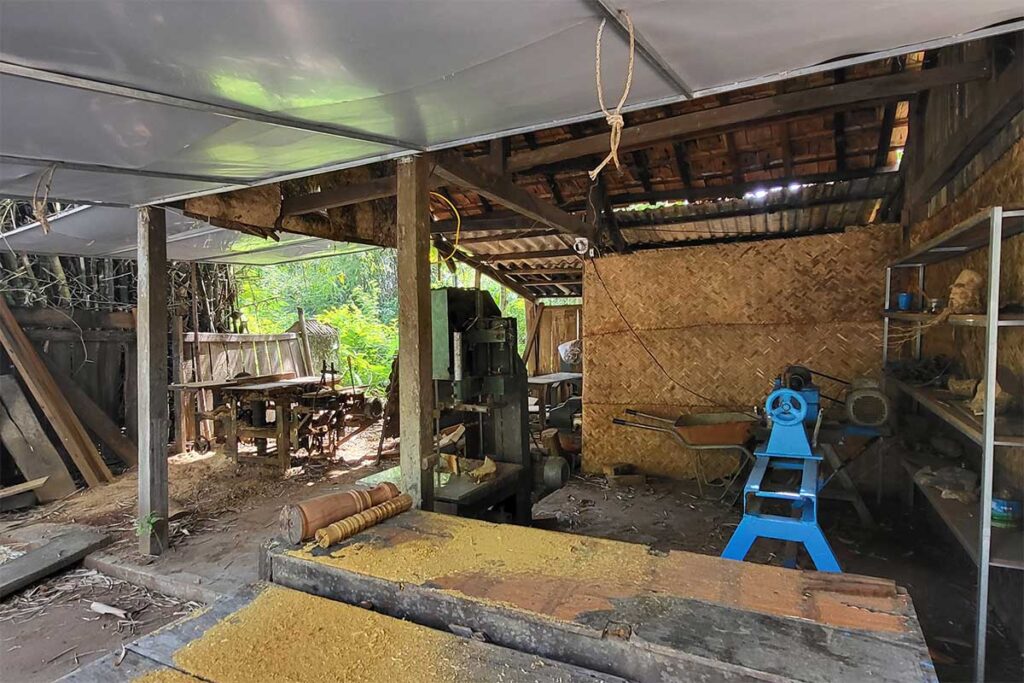
You’ll likely see boats on the Thu Bon River, women selling snacks or iced drinks, and elderly men chatting in courtyards. It’s a slow, genuine contrast to Hoi An’s more touristy vibe.
Ideal visit duration: 1 to 2 hours if you’re walking and browsing. Add more time if you join a carving class or combine it with other stops on Cam Kim Island.
Where it is & How to get there
Kim Bong Carpentry Village is located on Cam Kim Island, just across the Thu Bon River from Hoi An Ancient Town. It’s very close in distance, but feels a world away — quiet, green, and local.
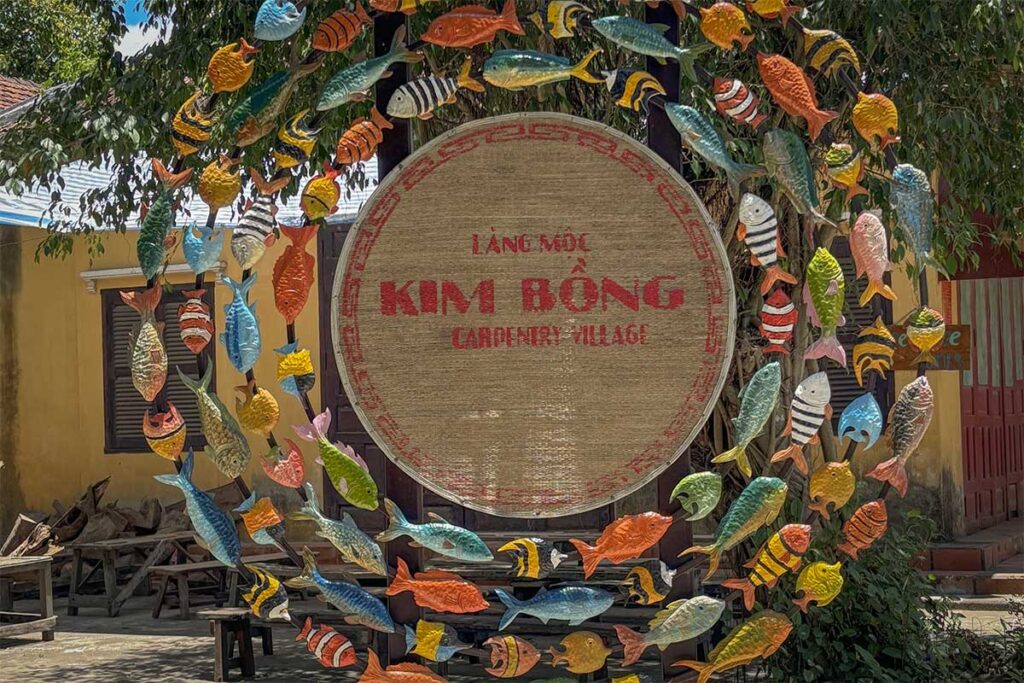
There are several easy ways to get there:
By boat (Most scenic)
From Bach Dang dock (just outside Hoi An market), you can hop on a small wooden passenger boat that crosses the river to Cam Kim. The ride takes about 10 minutes and offers a peaceful view of the town and river life.

Tip: Boats don’t run on a strict schedule — they go when a few people are ready. One-way costs are usually around 10,000–20,000 VND per person. Bring small cash. Alternatively, you can arrange a private boat to bring you there.
Once you arrive at the Cam Kim pier, Kim Bong Village is a short walk or bike ride away (about 5–10 minutes).
By Bicycle (Recommended)
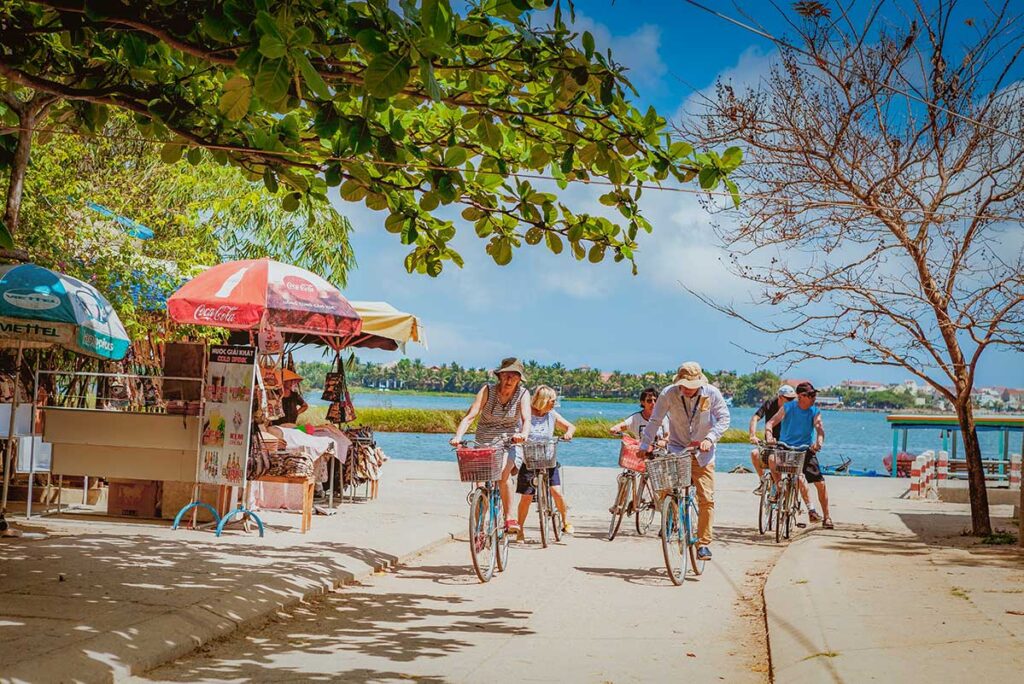
Cycling is one of the best ways to explore the area. The route from Hoi An to Kim Bong is flat, quiet, and scenic, passing small farms, gardens, and river views.
You can explore the whole of Cam Kim Island by bike — including Kim Bong, local rice paper workshops, mat weaving, and boatyards.
Tip: Combine this with a longer loop via Thanh Ha Pottery Village or Cam Thanh if you want to make it a full half-day trip.
By scooter (For confident riders)
If you’re comfortable driving a scooter, it’s a quick and flexible way to explore Cam Kim Island. The route is quiet and flat, but some small roads in the village can be a bit narrow or uneven.
Important: Bring your international driving permit, and only ride if you’re confident — scooters are not recommended for beginners.
By private car or taxi (Most convenient for a full itinerary)
If you want a relaxed visit without worrying about navigation, hiring a car with a driver or taking a taxi/Grab is the easiest way to get to Kim Bong Carpentry Village.
From Hoi An Old Town, the drive takes 10–15 minutes via the Cam Kim Bridge. This is a good option if you also want to visit Thanh Ha Pottery Village, the Hoi An Fish Market, or do a loop through the countryside — your driver can wait while you explore or drop you off and pick you up later.
Tip: You can arrange a custom half-day itinerary with stops at multiple craft villages, local markets, or a boat ride. It’s a good way to see more of the rural side of Hoi An without cycling.
Other craft villages around Hoi An
Hoi An didn’t thrive as a trading port on its own — it was supported by a network of craft villages along the Thu Bon River. Many of these villages still exist today, and you can visit them to see traditional skills that have been passed down for generations. Some are more commercial than others, but all offer a deeper look at local life beyond the Ancient Town.
Here are a few worth exploring:
Thanh Ha Pottery Village
Just a few kilometers west of town, this riverside village has been making pottery for over 400 years. You can walk through the village, visit the small museum, watch potters at work, and even try the wheel yourself.
Combine it with a visit to Thanh Ha Fish Market (early morning) or a boat ride along the Thu Bon River.
Tra Que Vegetable Village
Located between Hoi An and the beach, this organic farming village is famous for its herbs used in local dishes. You can cycle through the gardens of Tra Que, do a short farming tour, or join a cooking class here.
Great for families or anyone interested in Hoi An’s food culture.
Ban Thach Mat Weaving Village
A lesser-known spot near Cam Kim Island where families still weave sleeping mats by hand. Not touristy, but interesting if you want to see a traditional rural craft that’s slowly disappearing.
Ma Chau Silk Village
Located in Duy Xuyen district (around 10 km south of Hoi An), this village is known for silk weaving. It’s less visited but offers a chance to learn about silk production and see looms in action.
Can be visited on a longer countryside tour or with a guide.
Practical tips for visiting
- No ticket needed – Entry to the village and workshops is free. You’ll only pay for optional souvenirs or workshops.
- Best time to go is during the dry season (February to August). Mornings and late afternoons are cooler and more pleasant for walking or cycling.
- Dress casually and comfortably – You’ll likely walk or bike over uneven paths, and many workshops are open-air.
- Cycling is ideal – The flat roads of Cam Kim Island make it easy, and you’ll pass through quiet countryside.
- Guided tours can add value – Especially if you want to learn more about the craft history or combine it with other stops like Thanh Ha or the fish market.
- English is limited – Some artisans speak basic English, but a guide can help explain more about the techniques and history.
- Bring cash – If you’d like to buy souvenirs, most shops don’t accept cards.
Is it worth visiting?
Yes — if you’re looking to experience a more authentic, hands-on side of Hoi An. Kim Bong Carpentry Village offers a quiet, cultural contrast to the busy Ancient Town.
- Great for: curious travelers, photographers, woodcraft fans, and anyone interested in traditional Vietnamese life.
- Skip it if: you’re looking for big attractions, shopping, or nightlife — this is a peaceful place with slow rhythms.
- Best combined with nearby craft villages, a river cruise, or a half-day cycling route through Cam Kim and the Hoi An countryside.



